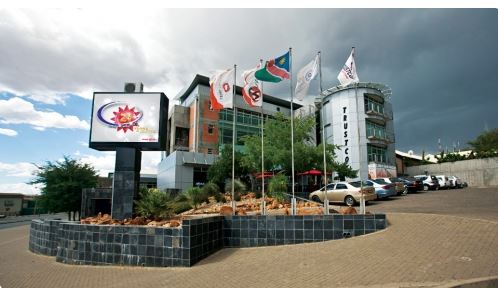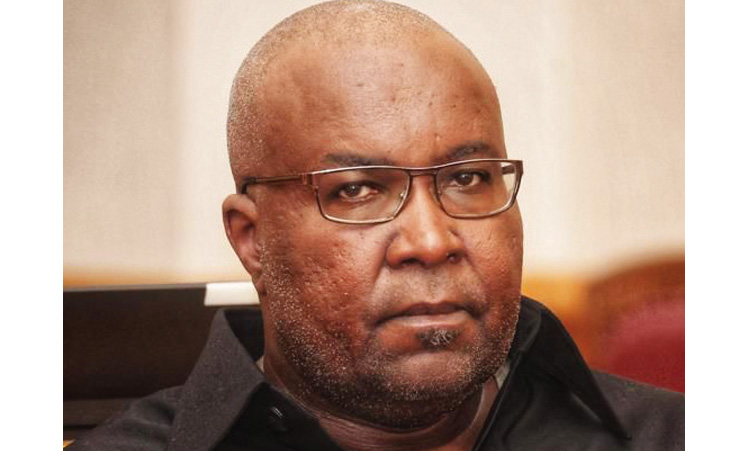CLAIMS by Ramatex that it made losses of up to N$500 million are devoid of all truth, according to the Labour Resources and Research Institution (LaRRI).
According to LaRRI, the Malaysian-owned textile factory that shut its operations last week, racked up N$488 million in exports to the United States in 2004, of which it only spent 11 per cent on wages. Ramatex does not dispute its export earnings, but claims to have spent 15 per cent more on wages.LaRRI’s Herbert Jauch pointed to trade data published by the United States department of Trade on its official AGOA (African Growth Opportunity Act) website, which, amongst others, listed textile imports from Namibia.Ramatex, which took advantage of Namibia’s duty-free import quotas under AGOA and the Multi-Fibre Agreement (MFA), was the only textile plant exporting clothes to the US under these agreements, Jauch pointed out.LaRRI calculated that Ramatex – despite claims of penury – only spent between 11 and 16 per cent of its export earnings on wages in Namibia.”Through the unions, we know exactly how many workers there were at Ramatex, and what each of them earned, including the Asian workers,” Jauch said in an interview.In 2004 – the year in which the MFA lapsed – Ramatex earned US$78,839 million in exports, while spending only 11,05 per cent of that on wages.The total wage bill for the 6 200 workers employed at the factory at that stage came to US$8,712 million.In 2006, the latest year for which figures are available, showed that Ramatex had earned about N$206 million from exports to the USA.By this time, the number of workers had dwindled to 3 400 Namibians and 400 Asians, who received a total of US$5,52 million in wages or 16,6 per cent of export earnings.In 2004, more than 33 per cent of the wages were paid to the 800 Asian workers (Chinese and Filipinos), who made up about 14,8 per cent of the workforce, an analysis of the figures showed.In 2006, about 35 per cent of the wage bill was spent on Ramatex’s 400 Asian workers, who comprised about 12 per cent of the total workforce at the time.Ramatex, which through its seven years in Namibia claimed that local workers were slow to train and were unproductive, imported large numbers of Chinese and Filipino textile workers, who earned up to four times as much as their Namibian counterparts, LaRRI’s research showed.Ramatex MD Bang Keon Ong, while not disputing the export earnings reported, claimed that their wage bill typically ran to 26 per cent of total cost, but could not provide hard figures.Seasonal fluctuations made business difficult, and their wage bill fluctuated between 21 and 26 per cent, Ong said.He insisted that local auditors PWC would provide proof, but the responsible partner has not returned any calls from The Namibian since Tuesday.Ong said Namibian operating costs were much higher than had been expected, including the rising bill for raw materials.”As a professional person, I cannot explain to someone who is not a professional [in textiles] what the costs are,” he insisted before ending the call.Ramatex however enjoyed tax exemption on profits, as well as free infrastructure provided by a N$100 million factory, purpose-built by the City of Windhoek, as well as subsidised water and electricity.As a multinational firm, it was difficult to establish where Ramatex had declared its profits, given that its sole aim was maximising its own profits, Jauch said.Ong declined to discuss this “for reasons of being a professional.”The Namibian Government had hoped to emulate the Mexican model – where a huge industry was created on the back of initial, small successes – in inviting Ramatex to Namibia.But given Ramatex’s local record, the State was clearly inexperienced in dealing with multi-nationals like Ramatex, which owns a string of factories in low-cost countries like China, Cambodia and Vietnam, Jauch said.Soon after the MFA agreement, aimed at giving developing countries a hand up in the US apparel market, expired at the end of 2004, rumours of Ramatex’ impending closure started circulating.”They started dismantling entire sections of the plant, and shipping that out – those were not repairs,” Jauch said.The plant was also accused by local environmental group Earthlife Namibia of causing very serious pollution of Windhoek’s groundwater, the results of toxic chemicals from the dyeing plant’s waste ponds overflowing into the surrounding areas.The company steadfastly declined to comment on these allegations, and the cost of cleaning this up was eventually passed onto Windhoek ratepayers as well, judging by an allocation in this regard in the City Council’s 2006-7 budget.At a joint press conference in early 2005, Ramatex pledged that they were not about to fire workers – only to lay off 1 500 workers two weeks later.The year before, the company had brought in 484 Bangladeshi workers.The Bangladeshis, who all signed contracts with Lichen Apparel, a Ramatex-owned entity, were quietly deported after their atrocious living conditions became public knowledge.Meanwhile, it has emerged that Ramatex has insisted that only its local subsidiary – Flamingo Clothing (Pty.) Ltd – was liable for the separation settlements of the last 2 800 workers, and not the Malaysian mother company, Ramatex Berhad.In 2007, Ramatex delisted from the Kuala Lumpur Stock Exchange, at which point 59 per cent of its shares were still owned by the Malaysian-Chinese Ma family.* John Grobler is a freelance journalist; 081 240 1587Ramatex does not dispute its export earnings, but claims to have spent 15 per cent more on wages.LaRRI’s Herbert Jauch pointed to trade data published by the United States department of Trade on its official AGOA (African Growth Opportunity Act) website, which, amongst others, listed textile imports from Namibia.Ramatex, which took advantage of Namibia’s duty-free import quotas under AGOA and the Multi-Fibre Agreement (MFA), was the only textile plant exporting clothes to the US under these agreements, Jauch pointed out.LaRRI calculated that Ramatex – despite claims of penury – only spent between 11 and 16 per cent of its export earnings on wages in Namibia.”Through the unions, we know exactly how many workers there were at Ramatex, and what each of them earned, including the Asian workers,” Jauch said in an interview.In 2004 – the year in which the MFA lapsed – Ramatex earned US$78,839 million in exports, while spending only 11,05 per cent of that on wages. The total wage bill for the 6 200 workers employed at the factory at that stage came to US$8,712 million.In 2006, the latest year for which figures are available, showed that Ramatex had earned about N$206 million from exports to the USA.By this time, the number of workers had dwindled to 3 400 Namibians and 400 Asians, who received a total of US$5,52 million in wages or 16,6 per cent of export earnings.In 2004, more than 33 per cent of the wages were paid to the 800 Asian workers (Chinese and Filipinos), who made up about 14,8 per cent of the workforce, an analysis of the figures showed.In 2006, about 35 per cent of the wage bill was spent on Ramatex’s 400 Asian workers, who comprised about 12 per cent of the total workforce at the time.Ramatex, which through its seven years in Namibia claimed that local workers were slow to train and were unproductive, imported large numbers of Chinese and Filipino textile workers, who earned up to four times as much as their Namibian counterparts, LaRRI’s research showed.Ramatex MD Bang Keon Ong, while not disputing the export earnings reported, claimed that their wage bill typically ran to 26 per cent of total cost, but could not provide hard figures.Seasonal fluctuations made business difficult, and their wage bill fluctuated between 21 and 26 per cent, Ong said.He insisted that local auditors PWC would provide proof, but the responsible partner has not returned any calls from The Namibian since Tuesday.Ong said Namibian operating costs were much higher than had been expected, including the rising bill for raw materials.”As a professional person, I cannot explain to someone who is not a professional [in textiles] what the costs are,” he insisted before ending the call.Ramatex however enjoyed tax exemption on profits, as well as free infrastructure provided by a N$100 million factory, purpose-built by the City of Windhoek, as well as subsidised water and electricity.As a multinational firm, it was difficult to establish where Ramatex had declared its profits, given that its sole aim was maximising its own profits, Jauch said.Ong declined to discuss this “for reasons of being a professional.”The Namibian Government had hoped to emulate the Mexican model – where a huge industry was created on the back of initial, small successes – in inviting Ramatex to Namibia.But given Ramatex’s local record, the State was clearly inexperienced in dealing with multi-nationals like Ramatex, which owns a string of factories in low-cost countries like China, Cambodia and Vietnam, Jauch said.Soon after the MFA agreement, aimed at giving developing countries a hand up in the US apparel market, expired at the end of 2004, rumours of Ramatex’ impending closure started circulating.”They started dismantling entire sections of the plant, and shipping that out – those were not repairs,” Jauch said.The plant was also accused by local environmental group Earthlife Namibia of causing very serious pollution of Windhoek’s groundwater, the results of toxic chemicals from the dyeing plant’s waste ponds overflowing into the surrounding areas.The company steadfastly declined to comment on these allegations, and the cost of cleaning this up was eventually passed onto Windhoek ratepayers as well, judging by an allocation in this regard in the City Council’s 2006-7 budget.At a joint press conference in early 2005, Ramatex pledged that they were not about to fire workers – only to lay off 1 500 workers two weeks later.The year before, the company had brought in 484 Bangladeshi workers.The Bangladeshis, who all signed contracts with Lichen Apparel, a Ramatex-owned entity, were quietly deported after their atrocious living conditions became public knowledge.Meanwhile, it has emerged that Ramatex has insisted that only its local subsidiary – Flamingo Clothing (Pty.) Ltd – was liable for the separation settlements of the last 2 800 workers, and not the Malaysian mother company, Ramatex Berhad.In 2007, Ramatex delisted from the Kuala Lumpur Stock Exchange, at which point 59 per cent of its shares were still owned by the Malaysian-Chinese Ma family.* John Grobler is a freelance journalist; 081 240 1587
Stay informed with The Namibian – your source for credible journalism. Get in-depth reporting and opinions for
only N$85 a month. Invest in journalism, invest in democracy –
Subscribe Now!










